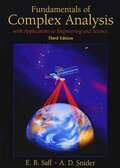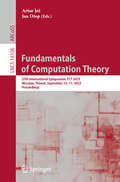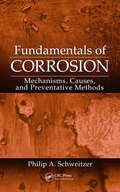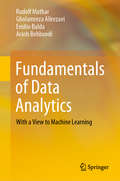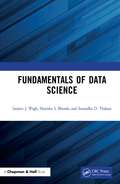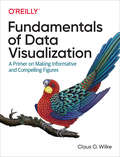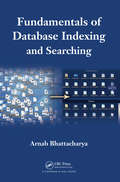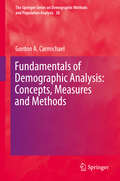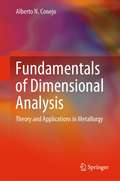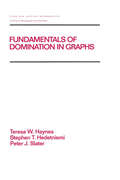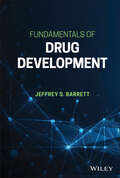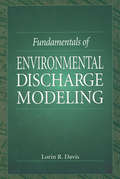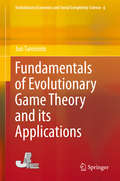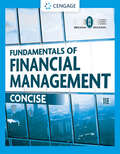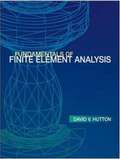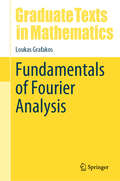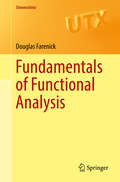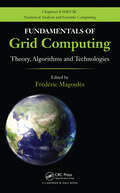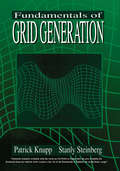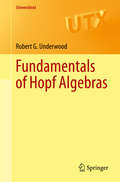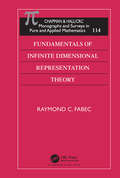- Table View
- List View
Fundamentals of Complex Analysis with Applications to Engineering and Science: Classic Version (Pearson Modern Classics for Advanced Mathematics)
by Edward Saff Arthur SniderThis is the best seller in this market. It provides a comprehensive introduction to complex variable theory and its applications to current engineering problems. It is designed to make the fundamentals of the subject more easily accessible to students who have little inclination to wade through the rigors of the axiomatic approach. Modeled after standard calculus books–both in level of exposition and layout–it incorporates physical applications throughout the presentation, so that the mathematical methodology appears less sterile to engineering students.
Fundamentals of Computation Theory: 25th International Symposium, FCT 2025, Wrocław, Poland, September 15–17, 2025, Proceedings (Lecture Notes in Computer Science #16106)
by Artur Jeż Jan OtopThis book constitutes the proceedings of the 25th International Symposium on Fundamentals of Computation Theory, FCT 2025, held in Wrocław, Poland, during September 15–17, 2025. The 32 full papers included in this volume were carefully reviewed and selected from 50 submissions. They present the fundamentals of computation theory including topics such as algorithms, complexity and formal methods.
Fundamentals of Corrosion: Mechanisms, Causes, and Preventative Methods (Corrosion Technology)
by P.E., Philip SchweitzerWritten by an authority in corrosion science, this reference offers a comprehensive description of the causes of corrosion as well as the means to limit or prevent it. It explains the mechanisms and forms of corrosion, the methods of attack on plastic materials, and the causes of failure in protective coatings, linings, and paints. Emphasizing atmospheric exposure, the text presents vital information regarding the design of structures, automobiles, household plumbing, manufacturing equipment, and other entities, as well as the effects of de-icing chemicals on highways and bridges.
Fundamentals of Data Analytics: With a View to Machine Learning
by Rudolf Mathar Gholamreza Alirezaei Emilio Balda Arash BehboodiThis book introduces the basic methodologies for successful data analytics. Matrix optimization and approximation are explained in detail and extensively applied to dimensionality reduction by principal component analysis and multidimensional scaling. Diffusion maps and spectral clustering are derived as powerful tools. The methodological overlap between data science and machine learning is emphasized by demonstrating how data science is used for classification as well as supervised and unsupervised learning.
Fundamentals of Data Science
by Sanjeev J. Wagh Manisha S. Bhende Anuradha D. ThakareFundamentals of Data Science is designed for students, academicians and practitioners with a complete walkthrough right from the foundational groundwork required to outlining all the concepts, techniques and tools required to understand Data Science. Data Science is an umbrella term for the non-traditional techniques and technologies that are required to collect, aggregate, process, and gain insights from massive datasets. This book offers all the processes, methodologies, various steps like data acquisition, pre-process, mining, prediction, and visualization tools for extracting insights from vast amounts of data by the use of various scientific methods, algorithms, and processes Readers will learn the steps necessary to create the application with SQl, NoSQL, Python, R, Matlab, Octave and Tablue. This book provides a stepwise approach to building solutions to data science applications right from understanding the fundamentals, performing data analytics to writing source code. All the concepts are discussed in simple English to help the community to become Data Scientist without much pre-requisite knowledge. Features : Simple strategies for developing statistical models that analyze data and detect patterns, trends, and relationships in data sets. Complete roadmap to Data Science approach with dedicatedsections which includes Fundamentals, Methodology and Tools. Focussed approach for learning and practice various Data Science Toolswith Sample code and examples for practice. Information is presented in an accessible way for students, researchers and academicians and professionals.
Fundamentals of Data Visualization: A Primer on Making Informative and Compelling Figures
by Claus O. WilkeEffective visualization is the best way to communicate information from the increasingly large and complex datasets in the natural and social sciences. But with the increasing power of visualization software today, scientists, engineers, and business analysts often have to navigate a bewildering array of visualization choices and options.This practical book takes you through many commonly encountered visualization problems, and it provides guidelines on how to turn large datasets into clear and compelling figures. What visualization type is best for the story you want to tell? How do you make informative figures that are visually pleasing? Author Claus O. Wilke teaches you the elements most critical to successful data visualization.Explore the basic concepts of color as a tool to highlight, distinguish, or represent a valueUnderstand the importance of redundant coding to ensure you provide key information in multiple waysUse the book’s visualizations directory, a graphical guide to commonly used types of data visualizationsGet extensive examples of good and bad figuresLearn how to use figures in a document or report and how employ them effectively to tell a compelling story
Fundamentals of Database Indexing and Searching
by Arnab BhattacharyaFundamentals of Database Indexing and Searching presents well-known database searching and indexing techniques. It focuses on similarity search queries, showing how to use distance functions to measure the notion of dissimilarity.After defining database queries and similarity search queries, the book organizes the most common and representative ind
Fundamentals of Demographic Analysis: Concepts, Measures and Methods
by Gordon A. CarmichaelThis book offers an ideal introduction to the analysis of demographic data. Inside, readers of all quantitative skill levels will find the information they need to develop a solid understanding of the methods used to study human populations and how they change over time due to such factors as birth, death, and migration. The comprehensive, systematic coverage defines basic concepts and introduces data sources; champions the use of Lexis diagrams as a device for visualizing demographic measures; highlights the importance of making comparisons (whether over time or between populations at a point in time) that control for differences in population composition; describes approaches to analyzing mortality, fertility, and migration; and details approaches to the important field of population projection. Throughout, the author makes the material accessible for readers through careful exposition, the use of examples, and other helpful features. This book's thorough coverage of basic concepts and principles lays a firm foundation for anyone contemplating undertaking demographic research, whether in a university setting or in a professional employment that takes on a demographic dimension requiring in-house training.
Fundamentals of Dimensional Analysis: Theory and Applications in Metallurgy
by Alberto N. ConejoThis is the first book which systematically describes an integral approach on dimensional analysis. The amount of textbooks on dimensional analysis is huge, however most of the books start with the definition of the relevant variables. When the variables are given to the reader without prior knowledge on each problem it has serious consequences: the usefulness of dimensional analysis is not appreciated, is not possible to understand the real challenges of this subject and the result, which is a general relationship with dimensionless groups is useless. This book closes the hole in previous books because in addition to describe step by step how to reach the general relationship with dimensionless groups, which creates solid basis of different metallurgical problems to understand the role of the relevant variables. It provides a full description on how to obtain the experimental data and applies the experimental data to transform the general relationship in a particular solution. Once the reader learns how to design the experimental work and uses that information to define the particular solution, it is possible to asses if the selection of variables was adequate or not. The book is useful for both undergraduate and graduate students.
Fundamentals of Domination in Graphs (Chapman & Hall/CRC Pure and Applied Mathematics)
by Teresa W. Haynes Stephen Hedetniemi Peter Slater"Provides the first comprehensive treatment of theoretical, algorithmic, and application aspects of domination in graphs-discussing fundamental results and major research accomplishments in an easy-to-understand style. Includes chapters on domination algorithms and NP-completeness as well as frameworks for domination."
Fundamentals of Drug Development
by Jeffrey S. BarrettFundamentals of DRUG DEVELOPMENT Enables readers to understand the process of pharmaceutical research, its regulatory basis, and how it fits into the global healthcare environment This book discusses how to conduct pharmaceutical research and the context for how the industry fits into global healthcare. Holistically, the well-qualified author helps readers and students of drug development appreciate the time and expense of the process. Specifically, the work identifies the emerging trends shaping the future of drug development, along with important related topics like generic drugs, data sharing, and collaboration. To aid in seamless reader comprehension, the book includes a glossary of terms and a self-assessment quiz for each chapter at the end. PowerPoint slides are also available as an online ancillary for adopting professors. Sample topics covered in the book include: Drug development and its phases Decision-making processes, drug development milestones, and compound progression metrics The various disciplines involved along with an assessment of the complexity and risks associated across the stages of development Differences in the nature and scope of development programs due to the therapeutic area of interest Associated costs and resources required Graduate students and professors teaching courses in drug development, drug discovery, pharmaceuticals, medicinal chemistry, and drug synthesis will be able to use this book as a complete resource for understanding all the complexities and nuances involved in the drug development process.
Fundamentals of Environmental Discharge Modeling (Mechanical and Aerospace Engineering Series #10)
by Lorin R. DavisThis book examines engineering and mathematical models for documenting and approving mechanical and environmental discharges. The author emphasizes engineering design considerations as well as applications to waste water and atmospheric discharges.Chapters discuss:the fundamentals of turbulent jet mixing, dilution concepts, and mixing zone conceptsdiffuser configurations and head loss calculationsdifferent modeling techniques and accepted models - discussed in detail with theoretical background, restrictions, input, output, and examplesLagrangian and the EPA UM 2-dimensional diffuser modelthe PLUMES interfaceEulerian integral methods, EPA UDKHG 3-dimensional diffuser model, and PDSG surface discharge modelempirical techniques, RSB diffuser model, the CORMIX family of models for both diffusers and surface dischargenumerical methods with a discussion of shelf commercial modelsGaussian atmospheric plume modelsFundamentals of Environmental Discharge Modeling includes numerous case studies and examples for each model and problem.
Fundamentals of Evolutionary Game Theory and its Applications
by Jun TanimotoThis book both summarizes the basic theory of evolutionary games and explains their developing applications, giving special attention to the 2-player, 2-strategy game. This game, usually termed a "2×2 game" in the jargon, has been deemed most important because it makes it possible to posit an archetype framework that can be extended to various applications for engineering, the social sciences, and even pure science fields spanning theoretical biology, physics, economics, politics, and information science. The 2×2 game is in fact one of the hottest issues in the field of statistical physics. The book first shows how the fundamental theory of the 2×2 game, based on so-called replicator dynamics, highlights its potential relation with nonlinear dynamical systems. This analytical approach implies that there is a gap between theoretical and reality-based prognoses observed in social systems of humans as well as in those of animal species. The book explains that this perceived gap is the result of an underlying reciprocity mechanism called social viscosity. As a second major point, the book puts a sharp focus on network reciprocity, one of the five fundamental mechanisms for adding social viscosity to a system and one that has been a great concern for study by statistical physicists in the past decade. The book explains how network reciprocity works for emerging cooperation, and readers can clearly understand the existence of substantial mechanics when the term "network reciprocity" is used. In the latter part of the book, readers will find several interesting examples in which evolutionary game theory is applied. One such example is traffic flow analysis. Traffic flow is one of the subjects that fluid dynamics can deal with, although flowing objects do not comprise a pure fluid but, rather, are a set of many particles. Applying the framework of evolutionary games to realistic traffic flows, the book reveals that social dilemma structures lie behind traffic flow.
Fundamentals of Financial Management: Concise
by Eugene F. Brigham Joel F. HoustonGain the understanding of today's financial markets and corporate financial management you need to propel you toward your goals with the contemporary insights and innovative learning tools found in Brigham/Houston's popular FUNDAMENTALS OF FINANCIAL MANAGEMENT: CONCISE, 11E. This market leader offers intriguing insights into the social responsibility of business, the significant effects of recent changes in corporate tax code, the ongoing multiple effects related to the economic impact of the coronavirus pandemic and other emerging issues straight from today's headlines. Clear explanations and real, meaningful examples help you understand the "what" and the "why" of corporate budgeting, financing, working capital decision making, forecasting, valuation and Time Value of Money. Hands-on exercises, cases, Excel spreadsheet models and interactive MindTap digital activities and learning modules guide you in putting the theory you learn into action.
Fundamentals of Finite Element Analysis
by David HuttonThis new text, intended for the senior undergraduate finite element course in mechanical, civil and aerospace engineering departments, gives students a solid, practical understanding of the principles of the finite element method within a variety of engineering applications. Hutton discusses basic theory of the finite element method while avoiding variational calculus, instead focusing upon the engineering mechanics and mathematical background that may be expected of senior engineering students. The text relies upon basic equilibrium principles, introduction of the principle of minimum potential energy, and the Galerkin finite element method, which readily allows application of finite element analysis to nonstructural problems.
Fundamentals of Fourier Analysis (Graduate Texts in Mathematics #302)
by Loukas GrafakosThis self-contained text introduces Euclidean Fourier Analysis to graduate students who have completed courses in Real Analysis and Complex Variables. It provides sufficient content for a two course sequence in Fourier Analysis or Harmonic Analysis at the graduate level. In true pedagogical spirit, each chapter presents a valuable selection of exercises with targeted hints that will assist the reader in the development of research skills. Proofs are presented with care and attention to detail. Examples are provided to enrich understanding and improve overall comprehension of the material. Carefully drawn illustrations build intuition in the proofs. Appendices contain background material for those that need to review key concepts. Compared with the author’s other GTM volumes (Classical Fourier Analysis and Modern Fourier Analysis), this text offers a more classroom-friendly approach as it contains shorter sections, more refined proofs, and a wider range of exercises. Topics include the Fourier Transform, Multipliers, Singular Integrals, Littlewood–Paley Theory, BMO, Hardy Spaces, and Weighted Estimates, and can be easily covered within two semesters.
Fundamentals of Functional Analysis
by Ammar KhanferThis textbook offers a comprehensive exploration of functional analysis, covering a wide range of topics. With over 150 solved examples and more than 320 problems, the book is designed to be both motivational and user-friendly for students for senior undergraduate and graduate courses in mathematics, providing clear and thorough explanations of all concepts. The second volume in a three-part series, this book delves into normed spaces, linear functionals, locally convex spaces, Banach spaces, Hilbert spaces, topology of Banach spaces, operators on Banach spaces and geometry of Banach spaces. The text is written in a clear and engaging style, making it ideal for independent study. It offers a valuable source for students seeking a deeper understanding of functional analysis, and provides a solid understanding of the topic.
Fundamentals of Functional Analysis
by Douglas FarenickThis book provides a unique path for graduate or advanced undergraduate students to begin studying the rich subject of functional analysis with fewer prerequisites than is normally required. The text begins with a self-contained and highly efficient introduction to topology and measure theory, which focuses on the essential notions required for the study of functional analysis, and which are often buried within full-length overviews of the subjects. This is particularly useful for those in applied mathematics, engineering, or physics who need to have a firm grasp of functional analysis, but not necessarily some of the more abstruse aspects of topology and measure theory normally encountered. The reader is assumed to only have knowledge of basic real analysis, complex analysis, and algebra. The latter part of the text provides an outstanding treatment of Banach space theory and operator theory, covering topics not usually found together in other books on functional analysis. Written in a clear, concise manner, and equipped with a rich array of interesting and important exercises and examples, this book can be read for an independent study, used as a text for a two-semester course, or as a self-contained reference for the researcher.
Fundamentals of Geometry Construction: The Math Behind the CAD (Springer Tracts in Mechanical Engineering)
by Jorge Angeles Damiano PasiniThe textbook provides both beginner and experienced CAD users with the math behind the CAD. The geometry tools introduced here help the reader exploit commercial CAD software to its fullest extent. In fact, the book enables the reader to go beyond what CAD software packages offer in their menus. Chapter 1 summarizes the basic Linear and Vector Algebra pertinent to vectors in 3D, with some novelties: the 2D form of the vector product and the manipulation of “larger" matrices and vectors by means of block-partitioning of larger arrays. In chapter 2 the relations among points, lines and curves in the plane are revised accordingly; the difference between curves representing functions and their geometric counterparts is emphasized. Geometric objects in 3D, namely, points, planes, lines and surfaces are the subject of chapter 3; of the latter, only quadrics are studied, to keep the discussion at an elementary level, but the interested reader is guided to the literature on splines. The concept of affine transformations, at the core of CAD software, is introduced in chapter 4, which includes applications of these transformations to the synthesis of curves and surfaces that would be extremely cumbersome to produce otherwise. The book, catering to various disciplines such as engineering, graphic design, animation and architecture, is kept discipline-independent, while including examples of interest to the various disciplines. Furthermore, the book can be an invaluable complement to undergraduate lectures on CAD.
Fundamentals of Geophysical Hydrodynamics
by Boris Khesin E. B. Gledzer Felix V. Dolzhansky A. E. GledzerThis newly-translated book takes the reader from the basic principles and conservation laws of hydrodynamics to the description of general atmospheric circulation. Among the topics covered are the Kelvin, Ertel and Rossby-Obukhov invariants, quasi-geostrophic equation, thermal wind, singular Helmholtz vortices, derivation of the Navier-Stokes equation, Kolmogorov's flow, hydrodynamic stability, and geophysical boundary layers. Generalizing V. Arnold's approach to hydrodynamics, the author ingeniously brings in an analogy of Coriolis forces acting on fluid with motion of the Euler heavy top and shows how this is used in the analysis of general atmospheric circulation. This book is based on popular graduate and undergraduate courses given by F.V.Dolzhansky at the Moscow Institute of Physics and Technology, and is the result of the author's highly acclaimed work in Moscow's Laboratory of Geophysical Hydrodynamics. Each chapter is full of examples and figures, exercises and hints, motivating and illustrating both theoretical and experimental results. The exposition is comprehensive yet user-friendly in engaging and exploring the broad range of topics for students and researchers in mathematics, physics, meteorology and engineering.
Fundamentals of Grid Computing: Theory, Algorithms and Technologies
by Frédéric MagoulèsThe integration and convergence of state-of-the-art technologies in the grid have enabled more flexible, automatic, and complex grid services to fulfill industrial and commercial needs, from the LHC at CERN to meteorological forecasting systems. Fundamentals of Grid Computing: Theory, Algorithms and Technologies discusses how the novel technologies
Fundamentals of Grid Generation
by Patrick Knupp Stanly SteinbergFundamentals of Grid Generation is an outstanding text/reference designed to introduce students in applied mathematics, mechanical engineering, and aerospace engineering to structured grid generation. It provides excellent reference material for practitioners in industry, and it presents new concepts to researchers. Readers will learn what boundary-conforming grids are, how to generate them, and how to devise their own methods. The text is written in a clear, intuitive style that doesn't get bogged down in unnecessary abstractions. Topics covered include planar, surface, and 3-D grid generation; numerical techniques; solution adaptivity; the finite volume approach to discretization of hosted equations; concepts from elementary differential geometry; and the transformation of differential operators to general coordinate systems. The book also reviews the literature on algebraic, conformal, orthogonal, hyperbolic, parabolic, elliptic, biharmonic, and variational approaches to grid generation. This unique volume closes with the author's original methods of variational grid generation.
Fundamentals of High Lift for Future Civil Aircraft: Contributions to the Final Symposium of the Collaborative Research Center 880, December 17-18, 2019, Braunschweig, Germany (Notes on Numerical Fluid Mechanics and Multidisciplinary Design #145)
by Rolf Radespiel Richard SemaanThis book reports on the latest numerical and experimental findings in the field of high-lift technologies. It covers interdisciplinary research subjects relating to scientific computing, aerodynamics, aeroacoustics, material sciences, aircraft structures, and flight mechanics. The respective chapters are based on papers presented at the Final Symposium of the Collaborative Research Center (CRC) 880, which was held on December 17-18, 2019 in Braunschweig, Germany. The conference and the research presented here were partly supported by the CRC 880 on “Fundamentals of High Lift for Future Civil Aircraft,” funded by the DFG (German Research Foundation). The papers offer timely insights into high-lift technologies for short take-off and landing aircraft, with a special focus on aeroacoustics, efficient high-lift, flight dynamics, and aircraft design.
Fundamentals of Hopf Algebras
by Robert G. UnderwoodThis text aims to provide graduate students with a self-contained introduction to topics that are at the forefront of modern algebra, namely, coalgebras, bialgebras and Hopf algebras. The last chapter (Chapter 4) discusses several applications of Hopf algebras, some of which are further developed in the author's 2011 publication, An Introduction to Hopf Algebras. The book may be used as the main text or as a supplementary text for a graduate algebra course. Prerequisites for this text include standard material on groups, rings, modules, algebraic extension fields, finite fields and linearly recursive sequences. The book consists of four chapters. Chapter 1 introduces algebras and coalgebras over a field K; Chapter 2 treats bialgebras; Chapter 3 discusses Hopf algebras and Chapter 4 consists of three applications of Hopf algebras. Each chapter begins with a short overview and ends with a collection of exercises which are designed to review and reinforce the material. Exercises range from straightforward applications of the theory to problems that are devised to challenge the reader. Questions for further study are provided after selected exercises. Most proofs are given in detail, though a few proofs are omitted since they are beyond the scope of this book.
Fundamentals of Infinite Dimensional Representation Theory (Monographs and Surveys in Pure and Applied Mathematics #114)
by Raymond C. FabecInfinite dimensional representation theory blossomed in the latter half of the twentieth century, developing in part with quantum mechanics and becoming one of the mainstays of modern mathematics. Fundamentals of Infinite Dimensional Representation Theory provides an accessible account of the topics in analytic group representation theory and operator algebras from which much of the subject has evolved. It presents new and old results in a coherent and natural manner and studies a number of tools useful in various areas of this diversely applied subject.From Borel spaces and selection theorems to Mackey's theory of induction, measures on homogeneous spaces, and the theory of left Hilbert algebras, the author's self-contained treatment allows readers to choose from a wide variety of topics and pursue them independently according to their needs. Beyond serving as both a general reference and as a text for those requiring a background in group-operator algebra representation theory, for careful readers, this monograph helps reveal not only the subject's utility, but also its inherent beauty.
